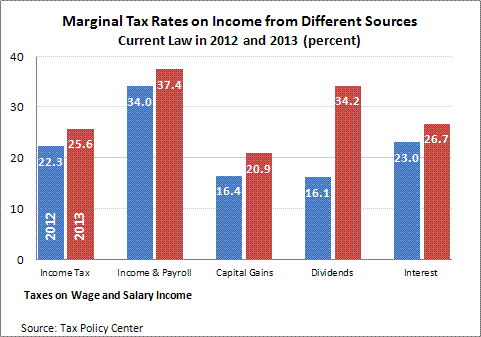How the Fiscal Cliff (and Tax Reform) Could Affect Tax Rates
Over at TaxVox, Roberton Williams writes about what will happen to tax rates under the fiscal cliff. Many economists believe that marginal tax rates (the tax rate on the next dollar earned) matter more than average tax rates (total taxes paid as a percent of income) in terms of the effect on economic growth. And under the fiscal cliff, marginal rates are due to rise.
While we tend to focus on ordinary income tax rates (the rates going up to 35 percent), Williams notes that there are many different tax rates that are due to rise under the fiscal cliff. While tax increases will be needed, the combination of expiring tax policies in addition to spending cut policies would have a devastating effect on the economy.
A helpful chart from the Tax Policy Center shows the different types of income that are due for an increase in marginal rates on January 1st. From left to right, the chart shows the increase in the individual income tax rate; the combined income and payroll tax rate; the capital gains tax rate; the dividends tax rate; and the rate on taxable interest.

While the fiscal cliff's marginal rate increases may be harmful for growth, it will be very difficult to fix our fiscal problems without more revenue. One option is to increase marginal income tax rates, but a better option is to broaden the base by reducing tax expenditures and making targeted changes to better define income. Plans like Simpson-Bowles allowed marginal rates to decrease while average tax rates (and thus revenue) increased.
Ultimately, tax reform will be a difficult balancing act in trying to raise more revenue, promote an efficient code, and at least maintain progressivity. Some tax provisions may make sense to keep in the code, but lawmakers should put everything on the table and have a thoughtful plan on taxes. Smart tax reform would certainly be better than the fiscal cliff.

